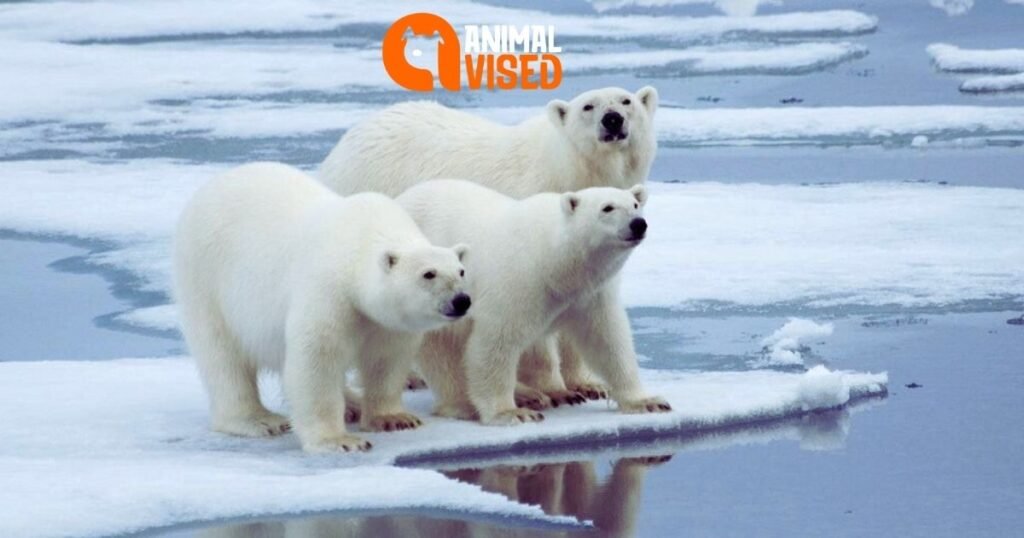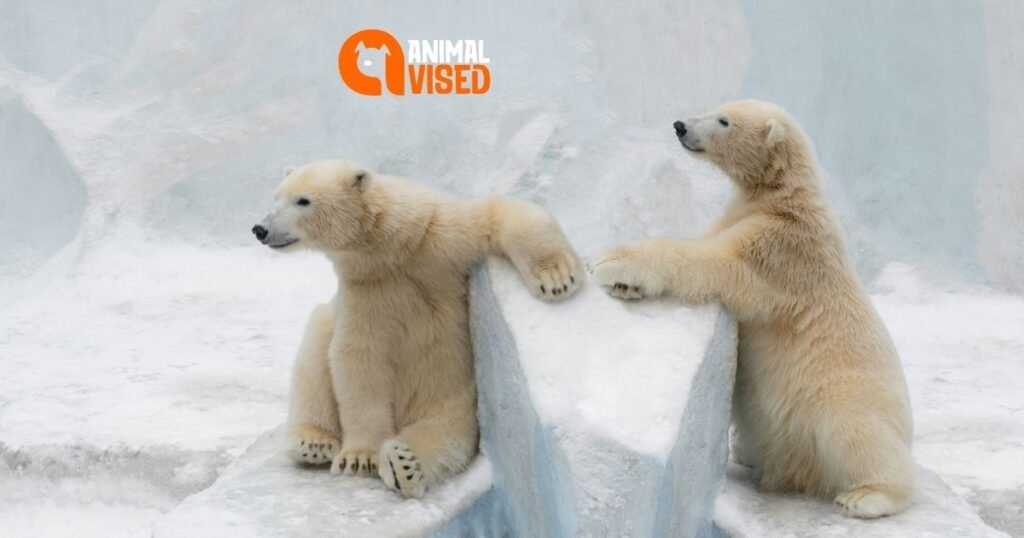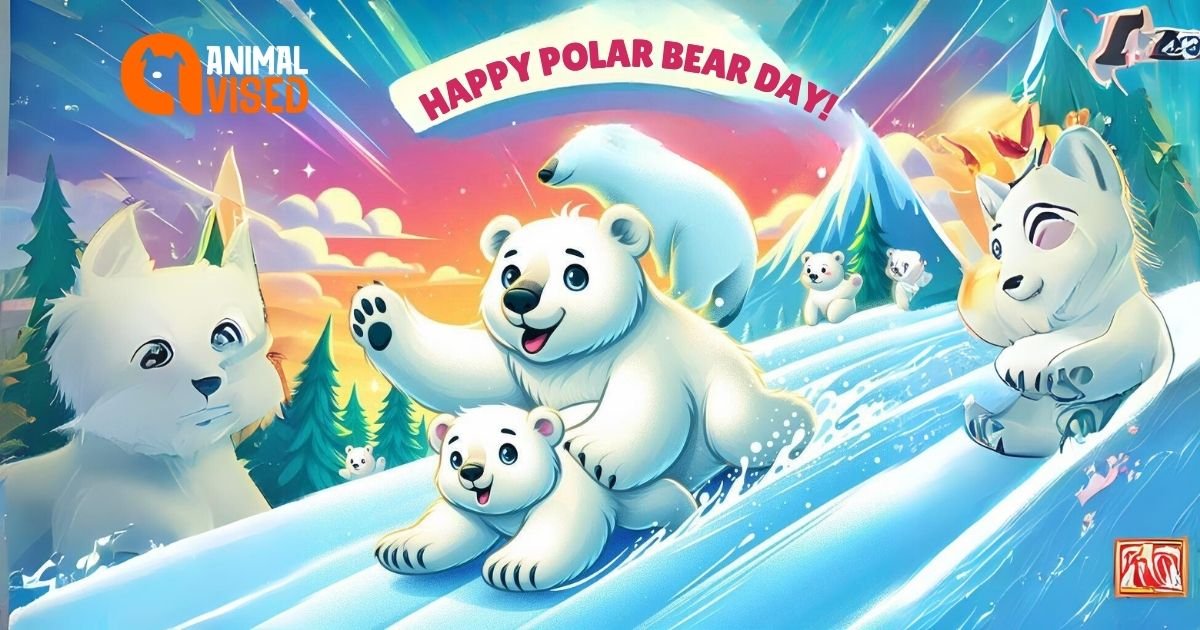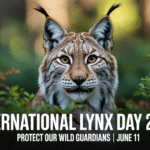Introduction
Welcome wildlife enthusiasts to this comprehensive guide to Polar Bear Day from your friends at Animal Vised! As majestic Arctic dwellers balancing on the climate change frontlines, polar bears worldwide urgently need our awareness and conservation support.
By exploring these magnificent carnivores and highlighting the threats they face, our goal is to inspire impactful activism on significant dates like World Polar Bear Day and beyond. Get ready for some frosty fun facts before we dive into serious environmental challenges!
Understanding Polar Bears
Let’s first equip ourselves with some polar bear fundamentals. Despite their cuddly reputations, these are powerful apex predators with incredible evolutionary adaptations enabling their iconic Arctic lifestyles:
Key Traits
- Largest extant bear species
- Thick water-repellent fur for insulation
- Heat-retaining dense underfur & fat
- Non-retractable claws to grip icy surfaces
- Keen sense of smell to detect prey
- Ability to swim continuously for days
Ranging across five circumpolar nations, polar bears primarily hunt ringed seals from the fragile sea ice they depend on year-round for feeding, migrating, and raising cubs. Polar Bear Day As highly threatened climate refugees, they serve as the poster species for dwindling biodiversity and ecological balance across Arctic regions.
Population Status
There are approximately 26,000 polar bears left worldwide per conservation groups. However, global warming has decimated their habitats drastically, with projections of over 30% population loss within decades. Polar Bear Day Several sub-populations are endangered. Their future survival hangs in the balance unless immediate climate action is taken!
Read More: Bears for Pets

Polar Bear Day Origins
Every February 27th, Polar Bear Day aims to harness public enthusiasm for these charismatic carnivores into meaningful action around conservation education, policy changes, and environmental protection across the vulnerable Arctic:
History
Polar Bear Day began from a proposal in 2012 by polar bear care staff at New York’s Utica Zoo who first floated the idea. Polar Bear Day It gained worldwide momentum among zoos and conservation bodies like Polar Bears International who backed turning it into an annual educational phenomenon.
Goals
As a collaboration between reputable NGOs and wildlife facilities with direct experience caring for polar bears, Polar Bear Day seeks to:
- Raise urgent awareness of their climate crisis plight
- Lobby governments on environmental regulations
- Inspire everyday citizens into activism on their behalf
- Support in-situ conservation programs internationally
From fun runs to documentary screenings and classroom talks, Polar Bear Day mobilizes support through peaceful public engagement coupled with hard scientific evidence presented by polar researchers worldwide. Polar Bear Day The outlook is dire, requiring coordinated efforts across countries, communities, and individuals to make a tangible difference!
Conservation Status Details
While their adorable fluffiness seduces us, the harsh survival struggles polar bears face as Arctic ecosystems fracture critically threaten this keystone species:
IUCN Red Listing
Classified as Vulnerable on the IUCN Red List of Threatened Species given significant recent population size reductions correlated to extensive sea ice habitat loss over three generations. High risk for extinction without intervention!
Sea Ice Decline
NASA reports September Arctic sea ice minimum extent has decreased by over 50% within recent decades alone as temperatures spike, decimating polar bear platforms for essential hunting and migration.
Starvation & Extinction Risk
With less sea ice access equating to reduced feeding abilities and nutritional stress, polar bear starvation events have escalated, along with desperate resource conflicts with human settlements. Researchers estimate two-thirds of polar bears face starvation by 2050 or even extinction within 100 years if climate change devastates their habitat.
Toxins & Health Issues
Industrial contaminants, offshore drilling, and pollution accumulate in Arctic ecosystems, entering food chains. Polar Bear Day This exposes polar bears to concerning levels of toxins that may impact fertility, hormones, and brain function plus weaken immunity – exacerbating climate threats.
Current Protective Legislation
Encouragingly, polar bears already benefit from robust legal scaffolding as beloved wildlife icons who significantly influence Arctic ecosystems and indigenous cultural heritage. This includes:
International Protections
Governed by the 1973 Agreement on the Conservation of Polar Bears binding all five polar nations to sustainably manage populations, including cooperation on monitoring, research, and enforcement policies.
National Laws
Domestically protected in the U.S. Marine Mammal Protection Act and Canada’s Species At Risk Act which upholds habitat stewardship, bans hunting except by natives, and promotes public education. Polar Bear Day Similar laws exist in Greenland, Norway, and Russia.
Trade Bans
Both legal and illegal trade of polar bear parts is prohibited globally under CITES Appendix II listing since 1975, preventing exploitative demand and commercial extinction. Harsh penalties apply for poaching or trafficking.
However, despite helpful statutes, actual implementation remains challenging as climate change and enforceability issues across remote Arctic terrain hamper conservation aims. More ground-level incentives and resources are essential.
Spotlight on Polar Bear Sub-Populations
Southern Beaufort Sea Bears (Alaska/Canada)
This southernmost group faced a 40% decline from 2001-2010 with only 900 remaining currently due to their habitat absorbing climate impacts soonest. Polar Bear Day Sea ice loss and starvation are their main threat. Indigenous-led stewardship initiatives aim to revive them.
Baffin Bay Bears (Greenland/ Canada)
Studies detected worrisome drops in cub survival and body condition as seasonal ice recedes earlier, causing this population of 2,800 bears to rely more on terrestrial prey and undergo risky open-water crossings to reach stable platforms.
Chukchi Sea Bears (Russia/Alaska)
Numbering only 3000 individuals divided between Russian and Alaskan waters, these bears contend with increasing industrial threats from shipping lanes and proposed oil drilling expanding into the U.S. side of this fragile habitat. They already suffer nutritional hardship from seabird prey declines.
Hudson Bay Bears (Canada)
This southerly group of polar bears located near Manitoba, Ontario, and Nunavut were the first to exhibit signs of climate change back in the 1980s-90s when diminished ice drove bears ashore prematurely, causing poor hunting and reproduction that required interventionist feeding plus adaptation research that continues today to secure their future.
Barents Sea Bears (Norway/Russia)
As a relatively stable population of almost 3000 bears covering Arctic territories overlapping Norway and Russia, these bears have weathered warming impacts better so far due to the moderating effects of the Gulf Stream. Yet longer-term uncertainties from ice loss loom, requiring proactive conservation.
Polar Bear Tourism Considerations
Ethical Viewing Standards
Seeing polar bears safely and respectfully in their natural habitat through responsible tourism provides crucial funding for Indigenous guardians while fostering public affinity. Ensure tour groups follow best practices like:
- No close-up interactions or cub approaches
- Zero habitat disturbances or pollution
- Supporting eco-lodges with sustainable practices
- Avoiding bus tours lacking qualified guides
Choose Wisely Where To Visit
- Prioritize Indigenous-run tours directly benefiting local communities and conservation versus exploitative ventures
- Research tour sustainability policies related to carbon footprints, waste, and environmental ethics
- Be realistic about vulnerable wildlife sighting probabilities affected by climate volatility
Set Reasonable Expectations
- Brace for harsh yet beautiful Arctic conditions requiring flexibility
- Remember safety is paramount in polar bear country – heed armed guide instructions
- Savor rare sightings however brief due to these bears covering vast roaming ranges
Reflect On Takeaways
- Bring back impactful first-hand accounts to strengthen advocacy
- Share compelling imagery mindfully with ethical usage guidelines
- Turn inspiration into actionable environmental pledges
Voluntour Ethically
- Seek volunteer opportunities directly supporting at-risk villages through community partnerships versus disruptive drop-in models sending unskilled labor

Celebrating Polar Bear Day
Now let’s explore some exciting ways individuals, organizations, and classrooms can celebrate World Polar Bear Day in impactful style!
Fun Activity Ideas
- Bake polar bear cupcakes or cookies for sweet fundraising events
- Craft handmade arctic dioramas from recycled materials
- Stage special zoo events spotlighting their polar bear residents
- Hold environmental clean-ups to prevent local water pollution
- Promote toy polar bear adoption drives by donating to conservation groups
Educational Initiatives
- Lobby schools to incorporate climate change curriculum including the plight of polar bears
- Arrange expert lectures on preserving polar bear habitats for students or the public
- Screen investigative documentaries highlighting threats polar bears face followed by solution-focused discussions
- Publish awareness articles or devote newspaper sections to the unfolding crisis
Community Engagement
- Lead engaging polar bear costume parades with conservation message tie-ins
- Partner with related NGOs on high-visibility polar bear mascot events
- Rally support through petitions, protests, and contacting elected representatives
- Harness art, music, and creativity for dynamic advocacy campaigns
Every positive effort shines more light on the challenges confronting polar bears while voicing public expectations for responsible environmental policies benefiting future generations.
Sustainability & Climate Activism
Preserving polar bears over the long term requires dramatically curbing atmospheric carbon heating the Arctic over twice as rapidly as other regions. Here are impactful actions everyone can take:
Individuals & Households
- Reduce personal carbon footprint related to home energy usage, transportation, flights, and diet
- Support green energy options and offset residual emissions
- Voice expectations to elected leaders for climate accountability
Businesses & Investors
- Implement and strengthen environmental sustainability frameworks related to operations, procurement, and supply chains
- Transition investments divesting from fossil fuels towards renewable energy leaders
- Adopt transparent carbon reporting and scientifically aligned emissions reduction targets
Indigenous Communities
- Amplify Indigenous voices within climate negotiations as frontline stewards of ancestral Arctic lands now transforming
- Fund Indigenous-led guardianship and land management programs empowering self-determined climate adaptation localized solutions
Educational Institutions
- Prioritize climate literacy within curriculums highlighting real-world species impacts like polar bears to motivate engagement
- Provide platforms for youth climate activism and amplify their voices demanding overdue political action
Governments & Policy Makers
- Enshrine specific wildlife protections and habitat conservation laws recognizing climate pressures
- Accelerate transitions from oil, gas, and coal infrastructure towards national renewable energy grids to meet Paris Agreement carbon reduction commitments
Through urgent unified efforts between corporations, activists, and authorities to mitigate emissions and slow feedback loops compounding Arctic threats – fragile species like polar bears still stand a fighting chance!
Charismatic Bears Worldwide
Polar bears instantly enchant us as ice kings and queens seemingly conjured from our wildest dreams. Polar Bear Day Yet fascinating bears spanning multiple habitats worldwide also need global support amid ever-encroaching human pressures:
Andean Bears
These South American natives named for their cloud forest domain peak public intrigue as the only bear found in equatorial ranges. Just 15,000 remain regionally. Habitat fragmentation and poaching primarily threaten them.
Asiatic Black Bears
Ranging across twelve Asian countries, these mesmerizing black-furred bears number under 50,000 continent-wide. Besides illegal trade for bear bile farming, they suffer from deforestation and persecution from perceived crop raiding.
Brown Bears
Iconic Eurasian and North American lineages like grizzlies and Kodiaks boast intricate social dynamics but contend with hunting, urban encroachment, and mass salmon die-offs removing crucial food provisions as insect populations indicating entire ecosystem collapses.
Giant Pandas
China’s endearing bamboo ambassadors require extensive intervention to ward off extinction threats as forest fragmentation isolates the 1,500 wild pandas remaining. Expanded protected corridors offer some hope.
Sloth Bears
Largely restricted to India and Sri Lanka, insect-loving sloth bears face escalating threats as sugar cane farms dominate their 10,000-strong range. Human altercations also lead to cub poaching and vicious bear-baiting events aimed at entertainment.
Sun Bears
The smallest bear breed existing, sun bears inhabit Southeast Asian rainforests where expanding palm oil plantations destroy the habitat of this rare tropical bear with under 10,000 surviving as their tree-dwelling and foraging sustenance disappears.
Healthy bear populations indicate balanced ecosystems benefitting all life. On World Bear Day or any opportunity in between – we can show support through bear-friendly choices plus activism preventing magnificent bears from fading as ghosts of the wild!

Related Awareness Days
While Polar Bear Day takes the icy spotlight, other noteworthy wildlife commemoration dates synergize for combined conservation impact:
World Wildlife Day (March 3)
These United Nations awareness events begun in 2014 feature annual wildlife themes to spotlight threats to at-risk species, habitats, and illicit trafficking prevention under global goals for sustainability, responsibility, and peaceful coexistence between wildlife and human communities.
Endangered Species Day (May 15)
First declared in 2006 by the United States, this conservation holiday educates on rapidly declining global biodiversity from hummingbirds to orangutans along with the worth of all creatures as sacred elements of our shared planet and the collective responsibility to protect them by reversing the impacts of human activity through environmental policies, protection laws and changes towards sustainable behavior.
World Animal Day (October 4)
Building on grassroots animal welfare movements, World Animal Day energizes public engagement, political lobbying plus threads between supporting organizations and educators for universal animal rights and dignity, emphasizing how compassion for all creatures including wildlife translates into overall progress for global justice, consciousness, and restoration of humankind’s relationship with nature.
Earth Day (April 22)
The original eco holiday with over 50 years of grassroots activism history around pollution, climate degradation plus infiltration of social and political spheres to drive large-scale environmental reforms. Current focuses include clean energy transitions, plastics reduction, and regenerative agriculture to heal ecosystems enabling wildlife to thrive amid a healthier biodiversity-sustaining balance.
Spotlight on Polar Bear Conservation Groups
A network of reputable organizations around the world actively study polar bear populations, advocate for environmental protections, and mobilize support through public education and research funding initiatives. Some noteworthy groups making a difference include:
Polar Bears International (PBI)
As a non-profit solely focused on polar bear conservation since 1992, PBI works across all polar nations conducting research on Arctic climate impacts and emerging threats to bears. They advance global campaigns, and educational summits, and promote sustainable stewardship of northern ecosystems vital to human and bear communities.
World Wildlife Fund (WWF) Arctic Program
Through science-based advocacy and collaborations plus policy pressure towards governments and industry – the WWF Arctic Program strategically spotlights rapid regional warming consequences, including mobilizing relief funds for at-risk villages while campaigning for zero emissions targets and habitat security enabling climate-adapted development not infringing on polar bears during Arctic resource rushes.
International Union for Conservation of Nature (IUCN) Polar Bear Specialist Group
This authoritative scientific body of polar researchers oversees the monitoring of global polar bear populations, habitats, and threats to inform dynamic conservation action plans prioritizing sustainability. As climate change escalates Arctic pressures, the IUCN provides urgent status updates and policy guidance protecting polar bears.
Indigenous-Led Conservation Initiatives
As original stewards of polar bear environments with generations of wisdom, groups like the Inuit Circumpolar Council, First Nations Polar Bear Patrol, and local sovereignty projects integrate traditional knowledge with modern science to steward polar bears respecting cultural values while empowering Northern communities balancing economic needs with safeguarding wildlife.
Polar Bear Conservation Success Stories
While estimated polar bear population declines are extremely concerning, some regional success stories demonstrate that strategic protective actions can stabilize at-risk groups when implemented effectively.
Southern Beaufort Sea Bears Rebound
After experiencing sharp drops between 2001-2010, this Alaskan/Yukon sub-population has rebounded recently to over 1000 bears credited to proactive conservation efforts championed by local Indigenous communities like:
- Managed limited trophy hunting caps preventing overharvests
- Monitored den disturbances and cub survivability stats to advise protection zones
- Reduced human-bear conflicts through waste management policies minimizing attractants
Chukchi Sea Bears Secure Habitat Designation
In Alaska’s Arctic National Wildlife Refuge, environmental allies won the long-fought designation of 1.6 million acres as permanently protected polar bear critical habitat in 2015, shielding birthing dens and migration routes for this vulnerable population already facing industrial threats as warming unlocks more northern oil/gas reserves.
Baffin Bay Strategy Buys Time
Creative seasonal fishing bans negotiated between Greenlandic villages and WWF to exclude areas where sea ice-reliant bears hunt seals have built goodwill reducing illegal kills by locals. This model compromise balancing community livelihoods and conservation buys time while longer-term climate mitigation ramps up regionally.
Gulf of Boothia Boom
Central Canada’s Gulf of Boothia polar bears have surged from just 900 in 2000 to over 1500 bears today – an unusual Arctic success story showing that in ecologically rich areas less impacted by climate change so far, curbing overhunting and prioritizing reproduction boosts numbers, but long term uncertainty persists.
Targeted collaborations bridging economic development and environmentalism through compromises allow polar bears brief respite. Yet preventing extinction ultimately requires binding international commitments slashing global carbon emissions heating their frozen kingdoms to collapse.
Polar Bear Day 2024: Celebrating the Arctic Icon and Beyond
Welcome to Animal Vised, your hub for exploring the fascinating world of animals! Today, we turn our focus to a majestic creature perfectly adapted to one of the harshest environments on Earth – the Polar Bear. Every year, on February 27th, we mark International Polar Bear Day, a day dedicated to raising awareness about the threats these magnificent animals face and the ongoing efforts to ensure their survival.
It’s important to distinguish between National Polar Bear Day and World Bear Day. While both days aim to raise awareness about bears, National Polar Bear Day specifically focuses on the plight of polar bears, while World Bear Day, celebrated on February 21st, celebrates all bear species globally. Similarly, International Brown Bear Day is held on May 8th to raise awareness about brown bears and their conservation needs.
However, Polar Bear Day holds a unique significance due to the vulnerable status of these iconic giants. Listed as “Vulnerable” on the International Union for the Conservation of Nature (IUCN) Red List, polar bears face a multitude of threats, primarily driven by climate change.
Understanding the Polar Bear: A Master of the Frigid
Polar bears are the largest land predators on Earth and the only true marine bear species. Perfectly adapted to the harsh Arctic environment, they boast thick fur, webbed paws for swimming, and a layer of blubber for insulation. These magnificent creatures are apex predators, playing a crucial role in maintaining the delicate balance of the Arctic ecosystem.
Unfortunately, due to climate change, the Arctic sea ice – their crucial hunting platform – is melting at an alarming rate. This loss of sea ice significantly impacts their ability to hunt seals, their primary food source. Consequently, polar bears face several challenges, including:
- Reduced hunting success: With less sea ice available, polar bears have difficulty finding and hunting seals, leading to malnutrition and decreased survival rates.
- Habitat loss: As the sea ice melts, polar bears lose valuable hunting grounds and denning sites, further impacting their survival.
- Increased competition: As the Arctic becomes more accessible due to melting ice, other predators like walruses might compete with polar bears for resources.
Polar Bear Day Activities: Raising Awareness and Taking Action
Polar Bear Day serves as a powerful reminder to learn about these remarkable creatures and understand the threats they face. Here are some ways you can participate:
Educate yourself and others:
- Dive into the world of polar bears by reading articles, watching documentaries, or attending online talks offered by reputable organizations.
- Share your knowledge with friends, family, and communities to raise awareness about the challenges polar bears face.
Support conservation efforts:
- Donate to reputable organizations like Polar Bears International, the World Wildlife Fund, or the National Wildlife Federation that are actively working to protect polar bears and their habitat.
- Consider volunteering your time or skills to support conservation initiatives if possible.
Reduce your carbon footprint:
- Climate change is the primary threat to polar bears. By adopting a sustainable lifestyle and reducing your carbon footprint, you can contribute to mitigating the impact of climate change.
- Simple steps like using energy-efficient appliances, choosing public transportation, and reducing your reliance on single-use plastics can make a difference.
Advocate for change:
- Make your voice heard! Contact your local representatives and urge them to support policies that address climate change and protect polar bears and their habitat.
- Participate in peaceful demonstrations or online campaigns to advocate for stronger environmental regulations.
Engage in responsible tourism:
- If you dream of seeing polar bears in the wild, choose responsible tourism companies that prioritize the well-being of the animals and their environment.
- Look for companies that are certified by organizations like the Marine Stewardship Council (MSC) or the Tour Operators Sustainable Tourism Partnership (TOSTP).
It’s important to differentiate between activities like watching live streams or documentaries, which are generally encouraged, and activities like interacting with captive polar bears, which can be harmful to the animals.
Beyond Polar Bear Day: Celebrating All Bears
While Polar Bear Day holds specific significance, it’s crucial to remember that all bear species play vital roles in their respective ecosystems. Here are some additional awareness days dedicated to different bear species:
- World Bear Day: Celebrated on February 21st, this day acknowledges the ecological and cultural significance of all bear species worldwide.
- Grizzly Bear Day: Observed on October 14th, this day raises awareness about the importance of grizzly bears and the threats they face in North America.
Recognizing Bear Diversity: Beyond the Arctic
While Polar Bear Day serves as a crucial reminder of the challenges faced by these magnificent creatures, it’s equally important to acknowledge the diversity and significance of all bear species across the globe.
Here, we delve into some additional awareness days dedicated to other bears:
1. International Brown Bear Day (May 8th): Celebrates the vital role of brown bears in various ecosystems, including North America, Europe, and Asia. This day highlights the threats they face, such as habitat loss due to human encroachment and poaching.
2. Giant Panda Day (September 17th): Raises awareness about the endangered status of giant pandas and the ongoing conservation efforts to ensure their survival. This day emphasizes the importance of protecting their bamboo habitat and supporting sustainable bamboo forestry practices.
3. Black Bear Appreciation Day (December 10th): Celebrates the ecological and cultural significance of black bears in North America. This day aims to foster responsible co-existence with black bears and educate the public about preventing human-bear conflicts.
4. Sun Bear Day (December 9th): Raises awareness about the critically endangered sun bear, found in Southeast Asia. This day highlights the threats they face from deforestation and the illegal wildlife trade, urging action for their conservation.
5. International Sloth Bear Day (October 21st): Celebrates the unique sloth bear found in India, Nepal, and Bhutan. This day focuses on raising awareness about their challenges, including habitat loss and conflict with humans, and promoting their conservation.
Each of these awareness days serves a crucial purpose in raising public awareness, promoting conservation efforts, and encouraging responsible human behavior towards these diverse bear species.
A Call to Action: Protecting Our Shared Future
Polar Bear Day and other bear awareness days serve as powerful reminders of the interconnectedness of our planet and the responsibility we have to protect vulnerable species. By educating ourselves, supporting conservation efforts, and advocating for change, we can contribute to a future where all bear species can thrive in their natural habitats.
Here’s what you can do:
- Stay informed: Stay updated on the challenges faced by different bear species and the ongoing conservation efforts.
- Support reputable organizations: Donate to or volunteer your time with organizations dedicated to bear conservation.
- Make responsible choices: Choose eco-friendly products and support companies committed to sustainable practices.
- Spread awareness: Share information about different bear species and conservation efforts with your friends, family, and communities.
By taking collective action, we can ensure that future generations can continue to witness the beauty and wonder of bears, both in the frigid Arctic and beyond.
Animal Vised encourages its readers to become responsible stewards of the environment and advocates for the protection of all bear species for a healthier and more biodiverse planet.
Conclusion
Preserving polar bears requires global cooperation on reversing ominous Arctic declines across numerous fronts – from sea ice loss and pervasive toxins to biodiversity threats and worsening extreme weather patterns compounding challenges for vulnerable northern communities, both human and ursine.
While time is running short, Polar Bear Day offers a positive forum to transform justified anxiety around their fate into constructive activism empowering citizens of every age and background into impactful environmental stewardship.

Through urgent climate policy reforms, green technology shifts, ecosystem protections and public education reinforcing our shared responsibility towards ecological balance and ethical coexistence – we can still secure the survival of magnificent polar bears while honoring Indigenous wisdom passed down over millennia in these hallowed Arctic storehouses of ancient natural mysteries.
Polar Bear Day reminds us while nature feels immense, it is not indestructible. Thus even individual voices or small gestures of care, when multiplied by masses, set change in motion preventing irreversible loss. Our planet’s future remains unwritten – through choosing hope and positive action, we each hold more influence than often realized.
Read More: Polar Bear Day
FAQs
Q: When is Polar Bear Day?
A: Polar Bear Day is celebrated annually on February 27th.
Q: Who founded Polar Bear Day?
A: Polar Bear Day was originally conceived in 2012 by zookeepers at the Utica Zoo in New York who cared for polar bears and wanted to raise awareness about conservation.
Q: What is the purpose of Polar Bear Day?
A: Polar Bear Day aims to educate people about threats facing polar bears, inspire activism and donations that support protection programs, and lobby governments on climate change policies that impact Arctic habitats.
Q: How can I celebrate Polar Bear Day?
A: Great ways to observe the day include organizing educational events, fundraising for conservation groups, participating in zoo polar bear activities, sharing infographics online, or contacting politicians regarding environmental priorities.
Q: What’s the current status of global polar bear populations?
A: There are estimated to be approximately 26,000 polar bears left worldwide, with declines projected around 30% over coming decades due to rapid sea ice loss and other climate change threats jeopardizing the species.
Q: Why does sea ice loss threaten polar bears?
A: Polar bears rely on Arctic sea ice as platforms for accessing ringed seals and other prey. Less sea ice means less hunting ability leading to starvation and population declines.
Q: How can I ethically see polar bears in the wild?
A: Responsible polar bear viewing includes joining Indigenous-led eco tours minimally impacting habitats while directly benefiting local conservation – always following best practices around safety distances and den disturbances.
Q: How can individuals help protect polar bears?
A: Everyday actions like reducing your carbon footprint, speaking out for climate policies, and protecting green spaces make a difference. Support groups conducting polar conservation programs through donations or volunteering.










